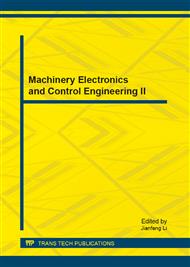[1]
Sulaiman, T. Kosaka, and N. Matsui, "High power density design of 6-Slot–8-Pole hybrid excitation flux switching machine for hybrid electric vehicles," IEEE Trans. Magn., vol. 47, pp.4453-4456, Oct. 2011.
DOI: 10.1109/tmag.2011.2140315
Google Scholar
[2]
N. Bianchi, M. D. Pré, and S. Bolognani, "Design of a Fault-Tolerant IPM Motor for Electric Power Steering," IEEE Tran. Vehicular Tech., vol. 55, pp.1102-1111, Jul. 2006.
DOI: 10.1109/tvt.2006.877716
Google Scholar
[3]
L. Parsa, and H. A. Toliyat, "Fault-Tolerant Interior-Permanent-Magnet Machines For Hybrid Electric Vehicle Applications," IEEE Tran. Vehicular Tech., vol. 56, pp.1546-1552, Jul. 2007.
DOI: 10.1109/tvt.2007.896978
Google Scholar
[4]
P. Zheng, J. Zhao, R. Liu, C. Tong, and Q. Wu, "Magnetic characteristics investigation of an axial-flux compound-structure PMSM used for HEVs," IEEE Trans. Magn. Vol. 46, pp.2191-2194, Jun. 2010.
DOI: 10.1109/tmag.2010.2042042
Google Scholar
[5]
G. Pellegrino, A. Vagati, P. Guglielmi, and B. Boazzo, "Performance comparison between surface-mounted and interior PM motor drives for electric vehicle application," IEEE Trans. Ind. Elec., vol. 59, pp.803-811, Feb. 2012.
DOI: 10.1109/tie.2011.2151825
Google Scholar
[6]
J. T. Chen, , Z. Q. Zhu, S. Iwasaki, and R. P. Deodhar, "A Novel Hybrid-Excited Switched-Flux Brushless AC Machine for EV/HEV Applications," IEEE Tran. Vehicular Tech., vol. 60, pp.1365-1373, May 2011.
DOI: 10.1109/tvt.2011.2132811
Google Scholar
[7]
G. Li, .J. Ojeda, E. Hoang, M. Gabsi, and M. Lécrivain," Thermal–Electromagnetic Analysis for Driving Cycles of Embedded Flux-Switching Permanent-Magnet Motors," IEEE Tran. Vehicular Tech., vol. 61, pp.140-151, Jan. 2012.
DOI: 10.1109/tvt.2011.2177283
Google Scholar
[8]
P. H. Nguyen, E. Hoang, and M. Gabsi, "Performance Synthesis of Permanent-Magnet Synchronous Machines During the Driving Cycle of a Hybrid Electric Vehicle," IEEE Tran. Vehicular Tech., vol. 60, pp.1991-1998, Jun. 2011.
DOI: 10.1109/tvt.2011.2118776
Google Scholar
[9]
J.P. Yang, "The current status and future outlook of the bonded rare-earth magnet" Journal of the Korean Magnetics Society, vol. 21, pp.147-150, Aug. 2011. (in Korean)
DOI: 10.4283/jkms.2011.21.4.147
Google Scholar
[10]
B. Fahimi, M. Ehsani, "Spatial distribution of acoustic noise caused by radial vibration in switched reluctance motors: application to design and control," in Proc. IEEE Conference on Ind. Appl., Rome, Italy, 8-12 Oct. 2000, pp.114-118
DOI: 10.1109/ias.2000.881034
Google Scholar
[11]
M. Abbasian, M. Moallem, B. Fahimi," Double-Stator Switched Reluctance Machines (DSSRM): Fundamentals and Magnetic Force Analysis," IEEE Trans. Energy Convers., vol. 25, no. 3, p.589–597, Sep. 2010.
DOI: 10.1109/tec.2010.2051547
Google Scholar
[12]
W. Jiang, M. Moallem, B. Fahimi and S. Pekarek, "Qualitative Investigation of Force Density Components in Electromechanical Energy Conversion Process", in Proc. IEEE Ind. Electron., IECON 2006 - 32nd Annual Conference, pp.1113-1118, Nov. 2006.
DOI: 10.1109/iecon.2006.347809
Google Scholar
[13]
A. C. Atkinson, A. N. Donev, and R. D. Tubias, Optimum experimental designs with SAS, Oxford University Press, 2007.
Google Scholar
[14]
L. Jolly, M. A. Jabbar, and L. Qinghua, "Design optimization of permanent magnet motors using response surface methodology and genetic algorithms," IEEE Transaction on Magnetics, vol. 41, pp.3928-3941, Oct. 2005.
DOI: 10.1109/tmag.2005.854966
Google Scholar
[15]
S. Kim, J. Hong, Y. Kim, H. Nam, and H. Cho, "Optimal design of slotless-type PMLSM considering multiple responses by response surface methodology," IEEE Transaction on Magnetics, vol. 42, pp.1219-1222, Apr. 2006.
DOI: 10.1109/tmag.2006.871950
Google Scholar
[16]
M. Abbasian and A. H. Isfahani, "Optimal Design of a Direct-Drive Permanent Magnet Synchronous Generator for Small-Scale Wind Energy Conversion Systems", Journal of Magnetics, vol. 16, no. 3, Dec. 2011.
DOI: 10.4283/jmag.2011.16.4.379
Google Scholar
[17]
S. Vaez-Zadeh, and A. H. Isfahani, "Multi-objective design optimization of air-core linear permanent-magnet synchronous motors for improved thrust and low magnet consumption," IEEE Transaction on Magnetics, vol. 42, pp.446-452, March 2006.
DOI: 10.1109/tmag.2005.863084
Google Scholar


